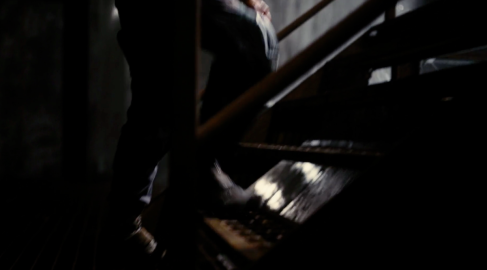-Explain how ‘Misfits’ uses superpowers as metaphors-

In Misfits the characters superpowers act as metaphors for each characters personality, insecurities, and desires, becoming a sort of short hand for the character. These powers remove them from society and turn them into Misfits, this is a metaphor for how there weird personalities and issues isolate them.
Simon
Simon is quiet and intense. He’s very neat, constantly straightening his jumpsuit and smoothing down his hair into a perfect position. He’s precise, and this, along with the intensity, can give him a creepy robotic quality. He’s also a bit of a nerd, suggesting the gang become super heroes and making other comic book references. He is shown to try and distance himself from the group and not make connections with the others.
On his own Simon wishes he had friends. He’s always invisible and unheard by others. He desires friendship as shown at the end of episode 1 when he uses his invisibility to hang around a group of people and pretend he’s part of them. Simon doesn’t have the confidence to talk to people or try and make friends. He distances himself from the others to avoid any pain he might get from social interaction. He doesn’t have the courage to show who he is to other people and have them decide if they accept him. So instead he hides from them, become invisible.
Simon’s power of invisibility comes from his feeling that no one notices him. The power is first triggered when he’s trying to get the attention of the others but they ignore him. The power is a metaphor for who Simon is; the invisible one, the quiet one in the corner no one notices and who lacks the confidence to speak up.
Kelly
Kelly is very aggressive and standoffish and confrontational to the other characters: if she doesn’t like someone’s behavior she’ll voice it loudly. However, she’s also very touchy and doesn’t like being insulted or doesn’t people judging her. The main times she snapped at other characters in the first episode was when they called her a chav. Kelly cares about what other people think off her.
At the end of episode 1 Kelly is shown solemnly taking off her make-up and letting her hair down. This shows the chav look and personality to be a costume, armor so that she can feel tougher against the world. She is shown to be more miserable and alone then she acts around others. She thinks the entire world hates and judges her and her only way to get through it is to toughen up.
Kelly’s mind reading is a way to see what people are thinking about her. It brings out that paranoia that people are judging her and turns it into a super power. This power is more often a curse, as she can hear things she doesn’t want to from the people around her.
Curtis
Curtis acts aloof and arrogant, often saying he shouldn’t be there. He thinks himself a famous runner forced to work with lesser young offenders. He’s a sporty person, always dressed in a vest to show his fit physique. Curtis is very touchy about his past because of the regret about his mistakes. Anytime someone brings up his career or his mistake he bites there head off.
In Private Curtis is filled with regret and longing for his past successes. He spends most of his time wallowing in his mistake as shown in at the end of episode 1, where he watches a tape of him running over and over. This scene also foreshadows how he wants to use his power; his desire to turn back time and save his running carer, shown by him rewinding the tape again and again. Curtis’s reverse time and it comes from his regret and desire to fix the mistake he made.
Alisha
Around the others Alisha is arrogant, cocky, vain, and seems used to getting her way. Alisha uses are body to get away with things and thinks she’s above everyone else because she’s pretty. She wants everyone to want her and so acts flirtatious around the others. From her stories we see she’s something of a promiscuous party girl
During a scene at the end of episode 1 Alisha is dressing herself up and getting ready to go out and presumably party. She’s getting ready for boys, dressing herself up so they’ll notice her. She’s alone and the only way she can feel less alone is by making boys want her and sleeping around. In the end she’s letting them use her. This is what her power is a metaphor for.
Her power is that anyone who touches her instantly lusts for her. But its meaningless lust, and the moment they stop touching her they forget what happened. So this could be a metaphor for the kind of relationships Alisha has had in the past, brief and meaningless; none of them really loved her.
Nathan
Around other people Nathan is cocky and arrogant. He always drives the scenes he’s in and becomes the center of attention. He mocks other people, being generally sarcastic, and isn’t affected by others comments. Even when someone’s threatening him he’ll make fun of them, an example being that he keeps making fun of Gary. Nathan is also very insensitive, making fun of Curtis with no regard for his troubled situation. Nathan will say whatever he’s thinking whenever he thinks it, with no regard for others.
In private Nathan has a more sensitive and sad side. He’s made homeless near the opening of the episode and feels rejected and alone. His mum throws him out and no friends will help him. As shown in the montage near the end of episode 1, with him stood outside his mums’ window looking in, Nathan feels alone. He already probably had abandonment issues as his father left, resulting in a broken house hold. This is where his desire to be the center of attention and his cold exterior, come from. He wants everyone to acknowledge him so that he feels less alone. His cold heart is to protect him from being hurt or abandoned again; he doesn’t let anyone in so they can’t hurt him. This is shown in his general treatment of the other characters and his resistance to a new father figure.
His power of immortality comes from his loneliness and tough exterior. In episode one his mum comments, “nothing anyone says ever hurts you” which foreshadows his immortality a bit. With his power nothing can hurt or kill him. It also ties into his fear of being alone forever, as being able to live forever he’ll always be alone, with anyone we meets ageing and dying as he goes on.
-Semiotics-
Semiotics is the science or study of signs.
Signs are images that communicate a meaning to the audience. Anything can be a sign as anything to tell others something. A persons clothing, behavior and body language can act as signs as they can be clues to who the person is.
Context can change the meaning of a sign. An example of this is the symbol X. This sign could be read a number of ways, it could be the letter X, it could be a kiss at the end of a letter, or it could be a mark of failure written after a wrongly answered question on a test. The context changes the X sign and gives it a different meaning.
Denotation: Simply the visual and physical description of the image, what it is at face value. E.g. man in all black cloths.
Connotation: Is a possible meaning of the image. E.g. man in black suit could be read as: man is depressed, man is a Goth, man is going to a funeral, etc.
Superman & The Comedian Image analysis –
These two images have many similarities. Both have a costumed superhero standing in front of the image of the American flag. However the two images have big differences and very different connotations and meanings come out of each.


Use of micro-elements in The Dark Knight Rises-
The Dark Knight Rises uses a combination of the four micro-elements; Camerawork, editing, sound and mis-en-scene to create meaning. Here they are used to shoe that Bane is strong, evil, and brutal, While Batman is the good guy but weaker.
Bane is shown to be a strong and intimidating man, as he is introduced with a low angle shot that makes the audience feel they are looking up at him, they’re smaller then him.
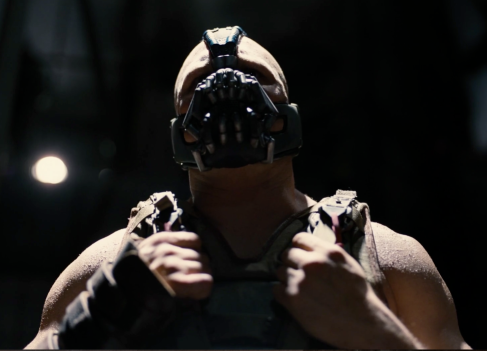
Bane punches Batman out of frame, becoming the only figure in the shot; Bane controls the scene; leads it.
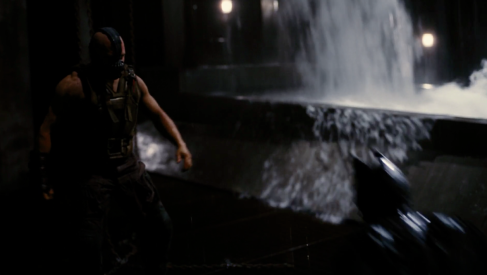
Although the camera work and pace is calm, with shots lasting quite a while, momentum is kept through constant movement by the camera. The camera pans, zooms, or rotates around the actions and makes some movement, however small, in each shot.
The pace of the editing is quite slow and lingering. Shots hold for quite a while rather than cutting on each punch. The editing doesn’t hide the violence and makes the fight a show of force rather then about skill. This pace also makes it less of a fight and more of a beat-down on Batman; Bane just hitting him over and over with others watching.
Reaction shots of Selina Kyle looking upset communicate how serious the fight is, she’s worried about Batman.

Reaction shots of Banes henchmen show they aren’t worried, they know Bane is going to win. Also, the fact that Bane has all these henchmen but doesn’t feel he needs them to defeat Batman shows how strong he is. Even as Batman hits Bane they don’t react.
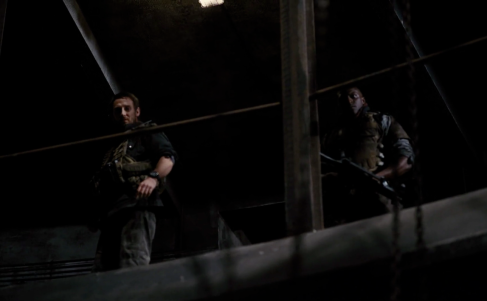
Bane looks visually stronger then Batman, his costume designed to leave his muscular arms bare and exposed and is combat gear adding to the bulk of his chest.
The lighting is dark and sinister. With spotlights pick out parts of the figures and contrasting with areas of shadow. This shows this is a dark and villainous scene, not a heroic one.
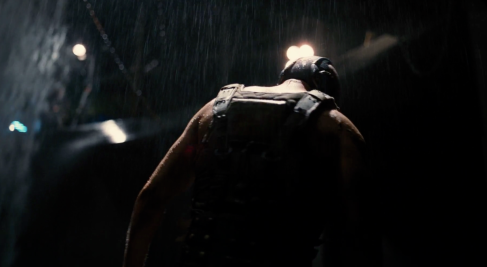
Bane is calm throughout, giving a speech over the whole fight. However Batman is grunting and roaring; he’s putting huge effort into the fight, he’s struggling.
There is no music in the scene but it’s really driven by the Foley punches. This emphasizes the brutality of the fight with the focus being on the punches and impacts.
Banes footsteps are huge and thudding, however Batman’s feet don’t make a sound. This emphasizes Banes mass and weight.
